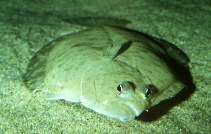| Family: |
Pleuronectidae (Righteye flounders), subfamily: Hippoglossinae |
| Max. size: |
53 cm TL (male/unsexed); 70 cm TL (female); max.weight: 3,700.0 g; max. reported age: 35 years |
| Environment: |
demersal; marine; depth range 0 - 550 m |
| Distribution: |
Northeastern Pacific: Bering Sea coast of Alaska to Islas Los Coronados, northern Baja California, Mexico. |
| Diagnosis: |
Dorsal spines (total): 0-0; Dorsal soft rays (total): 87-101; Anal spines: 0-0; Anal soft rays: 67-79; Vertebrae: 41-44. Dorsal origin over middle part of eye. Caudal longest in middle, ending in a broad 'V'. Pectoral fins large, bluntly pointed. |
| Biology: |
Adults are found on sand bottom (Ref. 2850), usually in deep water (Ref. 9988). Feed on invertebrates and bottom fishes (Ref. 6885). Livers of large individuals are a rich source of vitamin A (Ref. 6885). Marketed fresh or as frozen fillets (Ref. 2850). Eaten steamed, fried, micro-waved and baked (Ref. 9988). Generally regarded as the premium Pacific coast sole (Ref. 9988). |
| IUCN Red List Status: |
Least Concern (LC); Date assessed: 12 February 2021 Ref. (130435)
|
| Threat to humans: |
harmless |
Source and more info: www.fishbase.org. For personal, classroom, and other internal use only. Not for publication.

